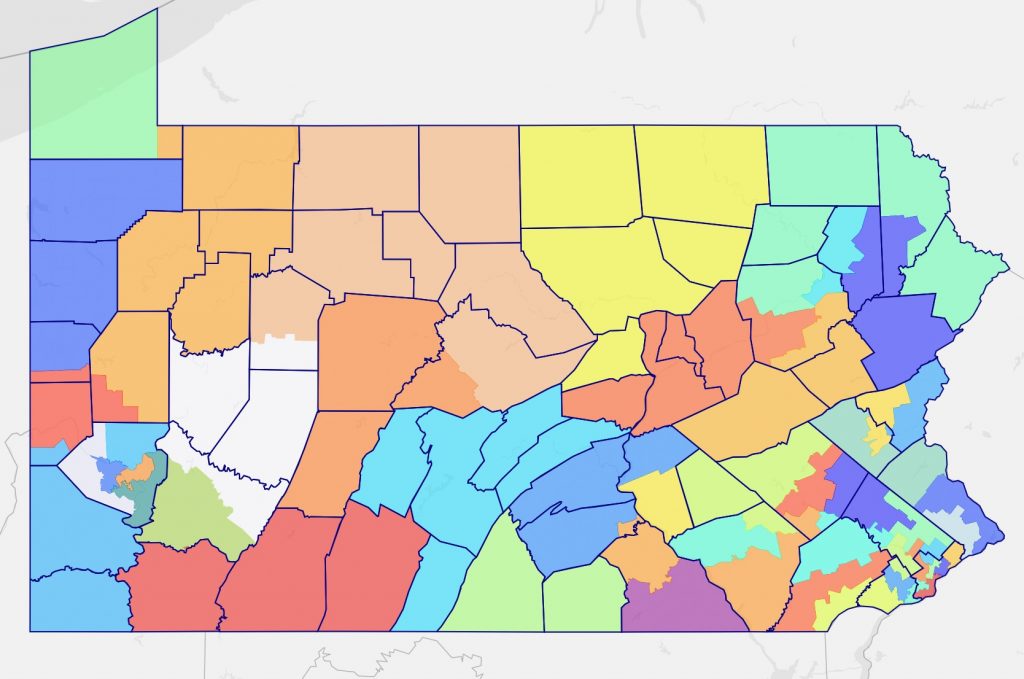by PA Spotlight Staff
February 9 2022
This article is part of a yearlong reporting project focused on redistricting and gerrymandering in Pennsylvania. It is made possible by the support of Spotlight PA members and Votebeat, a project focused on election integrity and voting access.
HARRISBURG — A panel has approved a final Pennsylvania Senate map that could make small changes to the partisan composition of the chamber while improving traditional metrics.
The map was created by the Legislative Reapportionment Commission, a five-person panel composed of an independent chair and the top legislative leaders. It voted 4-1 in early February to approve both the state House and Senate maps, with House Majority Leader Kerry Benninghoff (R., Centre) casting the lone no vote.
The process may not be over yet. Anyone can bring a challenge to either map to the state Supreme Court as part of a 30-day protest period that ends in early March.
The Pennsylvania Constitution explicitly lists four requirements for state House and Senate districts: compactness, contiguity, minimal splits, and equal population. Here’s how the final map stacks up on those and other measures:
>> MY MAP: Search now to see your old and new legislative districts
FREE NEWSLETTER
Sign up for a free roundup of the top news from across Pennsylvania, all in one daily or weekly email from Spotlight PA.
Compactness
Districts are meant to be compact, meaning as closely and neatly packed together as possible. This is intended to minimize any protrusions that would be isolated from the rest of the district.
However, there is no standard baseline of compactness, and neither the Pennsylvania Constitution nor the state Supreme Court has set a benchmark to measure it.
There are two commonly used metrics, however — the Reock and Polsby-Popper scales — and they show the final Senate map has an average compactness score that is slightly better than the current map.
On a scale of 0 to 1, where 1 equals maximum compactness, the final Senate map has a Reock score of 0.39 and a Polsby-Popper score of 0.33. The current map’s scores are 0.38 and 0.27, respectively.
Contiguity
Contiguity means that all districts are connected to each other and that no piece of a district is detached from the rest. The map fulfills this metric, except in Lancaster County where there are noncontiguous municipalities because of the way areas were annexed decades ago.
Split minimization
The Pennsylvania Constitution also requires that mapmakers not split counties, municipalities, or voting precincts “unless absolutely necessary.”
Compared to the current state Senate map, the final plan reduces the number of county and municipality splits: 53 to 47, and 11 to 10, respectively.
Population equality
Each district should have an equal population, though the U.S. Supreme Court has previously established that a deviation of 10% for the overall map is acceptable.
This plan deviation of 8.11% meets the requirement.
Partisan fairness
Partisan fairness measures whether a map is reflective of the partisan leaning of a state using a combination of metrics.
One such metric is proportionality, or whether the map would produce a group of officials that is reflective of the state’s partisan divide, based on past electoral data. Dave’s Redistricting, a nonpartisan mapping website where users can create and analyze district maps, rated this map “Very Good,” in terms of proportionality.
Republicans currently control the 50-seat state Senate, and Democrats hold 20 seats in the chamber.
The number of Democratic seats that is closest to proportional representation is 25 out of the total 50 seats. According to past election data, Dave’s Redistricting finds the likely number of Democratic seats under this map is 24.
The Princeton Gerrymandering Project, a nonpartisan group that reviews district plans across the country, also pegged the number of Democrat-leaning seats at 24 in an analysis for The Inquirer.
Competitiveness
Competitiveness refers to the number of districts that have a ratio of Democratic and Republican voters that results in neither party’s dominance. Advocates for a transparent and independent redistricting process believe that fewer “safe” districts result in more responsive legislators.
Dave’s Redistricting found 21% of the districts are competitive, while 22% of the current map’s districts are competitive. Both are still a far cry from what Dave’s Redistricting calls a good level of competitive districts, around 75%.
While You’re Here
If you learned something from this report, pay it forward and become a member of Spotlight PA so someone else can in the future.
Minority representation
In an effort to increase the representation of communities of color, which drove Pennsylvania’s growth over the past decade, the state Senate map creates minority-influence districts in Lehigh County and Philadelphia. That means a district where a minority community has a sizable voting bloc.
Overall, the plan improves minority representation compared to the current map. It has four majority-minority districts — one in which the majority of the population comes from one community of color. The current map has three. The new map also has five coalition-majority districts, which are areas where a combination of different communities of color constitutes the majority population.
This story was adapted from previous Spotlight PA reporting.
WHILE YOU’RE HERE… If you learned something from this story, pay it forward and become a member of Spotlight PA so someone else can in the future at spotlightpa.org/donate. Spotlight PA is funded by foundations and readers like you who are committed to accountability journalism that gets

